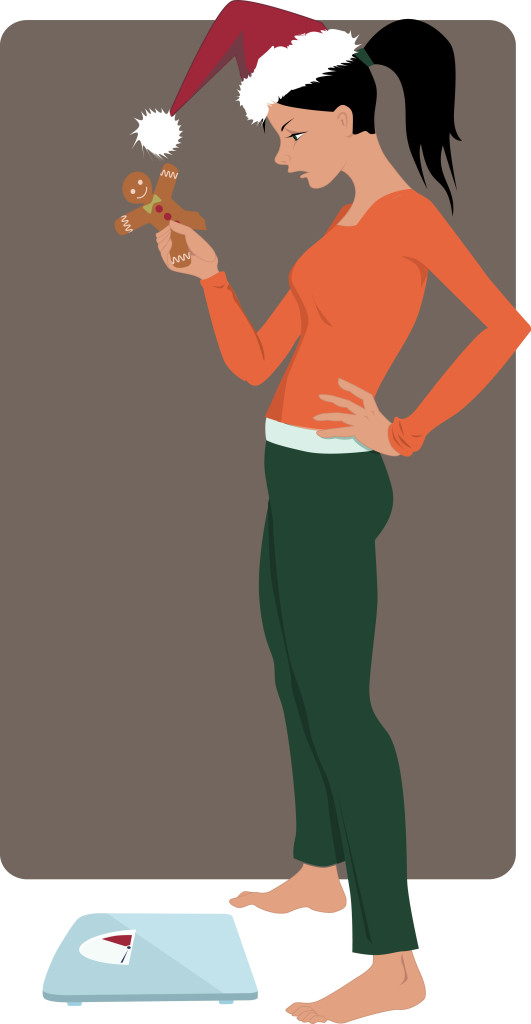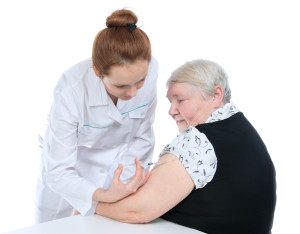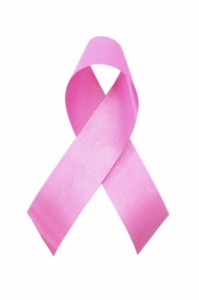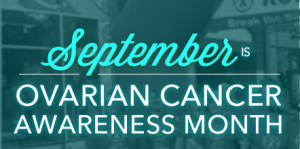 If you’re like thousands if not millions of Americans, you make New Year’s resolutions. And chances are, at least one of those resolutions has something to do with improving your health. Good for you! You only get one body in this lifetime, so taking care of it is important. Here’s how to succeed at keeping your resolutions:
If you’re like thousands if not millions of Americans, you make New Year’s resolutions. And chances are, at least one of those resolutions has something to do with improving your health. Good for you! You only get one body in this lifetime, so taking care of it is important. Here’s how to succeed at keeping your resolutions:
1. Write them down
Research has proved that people who write down their goals are more likely to achieve success. Break down your main goal—to lose weight, to eat better—into manageable steps. You can also break it down by time: monthly, weekly or daily.
2. Start small, then go big
So many people fail at their weight loss or healthy eating goals because they try to go from couch potato to marathon runner in January or give up everything they like to eat nothing but salad. Instead, start teaching yourself new habits one step at a time. Start off with something easy, like a 15-minute walk around the block. Once you’ve accomplished that, kick it up a notch. Keep going until you’re at the level of fitness you wanted to achieve. As for food, don’t think of anything as “bad” or “wrong.” Just remember that food is fuel, and plan to fuel yourself with healthier options.
3. Pay ahead of time
If you decide to take a workout class or join a gym, pay in advance. Once you’ve handed over the money, it’s harder to justify not going.
4. Plan your meals, snacks and drinks
Instead of deciding at the last minute what you’ll eat and drink all day, come up with a plan for healthy eating for the week and shop accordingly. Pack lunches to bring to work, or decide ahead of time what you’ll order from a nearby restaurant. And you’ll be less inclined to visit the vending machines at work if you have a variety of healthier snacks to choose from.
5. Do it now (whenever now is)
Instead of saying you’ll start tomorrow, do something good for yourself now. Drink an extra glass of water, reach for a healthy snack, take yourself out for a walk or run, or take 20 minutes to yourself to relax and read. Little changes add up.
6. Remember you’re human.
Instead of dwelling on slip-ups, be kind to yourself. Vow to get back on track instead of letting one unhealthy decision derail your progress.
What are your goals for better health in 2015? Share them below! And if you’re looking for an OB-GYN team that makes your health a priority and helps you achieve your goals, call Chouchani, Sayegh and Bagnarello and make an appointment. We are accepting new patients. And if you’re looking for more healthy tips for women, check out the patient education section of our website.
More
 The holidays are a great time for family get-togethers, conversation and of course, food. For those of us trying not to gain the 25 pounds of Christmas, following these simple tips and tricks can keep you trim this holiday season while still letting you sneak a few bites of those steaming hot gingerbread men.
The holidays are a great time for family get-togethers, conversation and of course, food. For those of us trying not to gain the 25 pounds of Christmas, following these simple tips and tricks can keep you trim this holiday season while still letting you sneak a few bites of those steaming hot gingerbread men.
Balance your beverages
Having holiday-themed drinks can be fun, and tasty, but are best consumed in moderation. Hot chocolate, eggnog, apple cider, holiday lattes etc. can be high in sugar and fat, leaving your diet plan damaged by the end of the day. However, the following small changes can help make your drink choices a little less detrimental:
- Avoid adding marshmallows, whipped cream or “drizzle” to your beverages
- Mix eggnog or hot chocolate with half a glass of skim/low-fat milk
- Look for low-fat/low-sugar options
- Avoid adding alcohol, as it mostly adds extra sugar and calories
- Drink a glass of water after each specialty beverage to help fill your stomach and prevent overconsumption
Eat smart, don’t be a Scrooge
Starvation and dietary self-sacrifice during the holiday dinners and parties will only lead to aggravation and irritation. Besides, no one wants to hear about and all the things you can’t eat while they tear into that Christmas turkey. However, the next few adjustments can help keep you, your belly and your loved ones happy this season:
- Choose light over dark meat and avoid eating the skin for less calories and fat
- Be aware of how much you’re putting on your plate
- Avoid too much gravy or dressing in order to limit fat, calories and sodium
- Choose whole-grain breads, lean meats, nuts, veggies and fruits for appetizers
- Consume sweets/deserts in moderation or split your choice with a friend
Kitchen smart, kitchen savvy
Whether cooking for a work party or family dinner, making smarter food choices can help you and others have a healthier holiday.
- Use fresh fruits and vegetables instead of the canned option
- Use herbs and spices to flavor your masterpiece instead of loading it up with butter and salt
- Complement heavy dishes with roasted vegetables or a tossed salad
- Use whole-wheat flour instead of white flour when baking
- Cook with vegetable or olive oil instead of butter
- Use low-fat or skim milk instead of heavy cream
- Add dried fruit to baked goods instead of candies or chocolate chips
- Flavor dishes with vanilla, almond and peppermint extracts instead of butter and sugar
Win over the workplace
Work parties and functions can be the most difficult place to refuse poor food choices. But, by signing up to bring your own dish you can provide a healthy option for you and others.
Making sure to eat healthy throughout the day can also prevent you from overeating poor food choices later by keeping your stomach full and satisfied, and your mind away from unhealthy cravings.
Avoid fried and buttered foods and keep away from items with an abundance of cheese and cream. Supplement instead with grilled items, vegetables and dip or whole grain crackers.
Stay active despite the snow
The change in the weather means more layers, less daylight and an overall tendency to avoid leaving the house whatsoever. However, one of the best ways to retain your fitness physique is by beginning or maintaining an exercise regimen.
If you choose to workout outside, it’s important to wear the right gear, usually including sweat-wicking fabrics, and to keep important parts of your body covered with gloves, ear bands etc. It’s important to stay hydrated by drinking fluids before and after your workout, even if you aren’t thirsty.
Taking a walk, stretching or playing a holiday party game can be a great way to get your digestive system moving after dinner.
The holidays can be a great time to relax and enjoy time with family, friends and loved ones. This season, don’t let your inner Grinch take over! Keep an eye on the little choices you make. After a while, those calories can really add up!
More

According to the Center for Disease Control (CDC) adults should aim for 7-8 hours of sleep per night, however, balancing work, holiday shopping, family activities etc. can quickly impede on that valuable slumber. Not getting enough sleep can lead to sleepiness and lethargy, making it difficult to accomplish what is needed for the day.
Maintaining a proper amount of sleep can prevent and control chronic illnesses like diabetes, cardiovascular disease, obesity and depression. The CDC states that most adults report a sleeping problem one or more nights a week, including symptoms of sleep disorders like insomnia where it’s extremely difficult to fall asleep at all.
The National Institute of Health recommends the following number of sleep hours per person each night:
Newborns: 16-18 hours
Preschool age: 11-12 hours
School age: At least 10 hours
Teens: 9-10 hours
Adults/Seniors: 7-8 hours
Now, finding time for those 7-8 hours each day can be quite a challenge, however, consequences of poor sleep habits and sleep deprivation can lead to:
- Depression
- Memory problems
- Weaker immune system/more likely to get sick
- Decreased pain tolerance
- Trouble focusing your eyes
- Cannot stop yawning
- Daydreaming/wandering thoughts
According to the National Highway Traffic Safety Administration, driving while experiencing fatigue or sleep deprivation is responsible for approximately 100,000 car accidents and 1550 deaths each year. Sleep deprivation also magnifies the effects of alcohol, making a fatigued person far more likely to become impaired than a well-rested one.
Figuring out how much sleep you need is dependent on your age, body type and daily activities. Studies have deduced that after mapping different individual’s sleep patterns, sleep needs vary dependent on the person. Someone of the same age and gender may function fine on 7 hours of sleep a night, while someone with the same characteristics may feel their best after a solid 9 hours.
“Sleep debt,” or the amount of time where the body should have slept but wasn’t able to, can be “paid off” with additional hours slept on days off or by going to bed an hour earlier each night. In addition, researchers from the National Sleep Foundation have found that oversleeping or sleeping too much can cause depression and other health problems as well, with an increase in morbidity and mortality after continuously sleeping more than 9 hours a night.
To better your quality of sleep and assure you get the best amount of sleep for your lifestyle, it’s important to follow these tips:
- Establish a continuous sleep schedule during the week and on weekends
- Practice a relaxing routine an hour before bed each night
- Create and maintain a comfortable sleeping environment
- Only use your bedroom for sleeping, keeping other distractions such as TV in other rooms
- Finish your daily food intake 2-3 hours before bedtime
- Maintain a regular exercise schedule
- Avoid caffeine and alcohol before bedtime
- Avoid smoking cigarettes
Making sleep a priority can be one of the most important choices you make in your adult life. Extended sleep deprivation can cause sleepiness during the day, leg cramps or tingling, snoring, difficulty breathing during sleep or prolonged insomnia. If these symptoms persist, its recommended that you contact your primary care physician about sleep-related disorders etc.
Without proper sleep, the human body will slowly begin to break down as it doesn’t have the right amount of energy to perform all the tasks needed on a daily basis. Don’t compromise yourself or your immune system, especially during the winter! Know your body and know yourself. The right amount of sleep can make all the difference!
More
 For anyone attempting to lose weight around the holidays, Thanksgiving is a prime night for temptation and guilty pleasure. However, there are ways to watch your weight around that glistening, golden brown turkey this November.
For anyone attempting to lose weight around the holidays, Thanksgiving is a prime night for temptation and guilty pleasure. However, there are ways to watch your weight around that glistening, golden brown turkey this November.
Thanksgiving is a time for the declaration of what you’re grateful for, so why not start out the season with the recognition of thanks for your health. So begin the season in a positive way, avoid the domino effect of stuffing your face after the Macy’s parade.
Take a walk after eating.
Though it may seem silly, announce your venture right before dinner, and some of your family or friends may want to join. A walk in the cool weather will not only help your food start digesting, but it may also deter your thoughts from dessert.
Focus on family.
Instead of constantly thinking about all the food you could be or will be eating, keep your mind on the celebration. Spend your time enjoying all the sounds, smells and company that doesn’t come around too often, and truly take time to absorb the season for what it was meant for instead of thinking in circles about how you “can’t have” all the pie you’d like.
Team up.
Make plans with a friend or family member for the morning following Thanksgiving festivities. Working out can immediately decrease feeling tired or worn down, and creating a commitment with another person can show how serious you are about not putting on weight throughout the holidays. In addition, having a morning workout listed on next-day’s schedule may deter you from overeating the night before.
Follow the reason for the season.
Instead of sitting around at the table or helping yourself to another pile of leftovers, offer to help clean up the table or wash the dishes afterwards. Not only will moving around help digest your food, but it will distract you from the additional helpings and deserts you might have otherwise put on your plate.
Eat when you’re hungry and stop when you’re full.
This cardinal rule can be the best advice for dieters everywhere, though it may not be the easiest mantra to follow. Plan to attend your holiday meal with the mindset of stopping eating when you’re not hungry anymore.
Most people attend Thanksgiving under the impression that they’re going to eat until they’re stuffed full, often making themselves feel sick and unwilling to do much afterword. By eating in moderation you can enjoy the holiday without setting yourself back too far.
Thanksgiving can be a wonderful opportunity to choose what truly makes a difference in our lives for the better. Here at our practice, we’re truly thankful for the opportunity to provide care to you as our patients and ultimately as our friends. So, this holiday season we encourage you to be as thankful for yourselves and your health as we are for you. Happy Thanksgiving from all of us at Chouchani, Sayegh and Bagnarello M.D.! Wishing you a health and fun-filled holiday.
More
 According to the Center for Disease Control, “Flu season” in the United States begins in October and may continue as late as May. Influenza, or the flu virus, includes the following symptoms:
According to the Center for Disease Control, “Flu season” in the United States begins in October and may continue as late as May. Influenza, or the flu virus, includes the following symptoms:
- Cough and/or sore throat
- Runny/stuffy nose
- Headaches or body aches
- Fever of 100 degrees Fahrenheit or higher
- Chills
- Fatigue
- Nausea and vomiting
Anyone six months and older can receive a flu shot and it is recommended that most people be vaccinated each season. A vaccination can be administered nasally or injected through the skin. Injections can be trivalent, effecting three different types of viruses, or quadrivalent, meaning they’ll fight against four types of flu viruses.
Alongside flu hype can be misleading myths and misconceptions, which may include the following:
Myth #1: Cold weather causes the flu.
Going outside in the cold cannot increase your risk of flu. Though the flu season may coordinate with the colder months, there is no real coordination. The only real connection to the spread of the flu virus and the weather, is the increase of contact in close quarters during the colder months.
Myth #2: The seasonal flu is annoying but not harmful.
Though some consider the flu “just a bad cold,” the symptoms of the flu often rival any seasonal cold symptoms. For example, a cold may include a runny nose, sinus congestion and a sore throat, where the flu often makes those who contract it feel as though they’ve been “hit by a truck.” with a fever, body aches, nausea and possible vomiting.
Myth 3#: You can get swine flu from pork-based products.
After the recent swine-flu scare some people swore of pork, bacon etc. However, experts have stated there is no way to contract the flu virus from pork-based products.
Myth #4: The flu vaccine can give you the flu.
This being the most common myth, experts have openly stated that there is no possible way that you can contract the flu from the flu vaccine. The flu vaccine only contains a dead virus and cannot actually infect the patient, and in the FluMist nasal spray, the live virus is specially engineered to kill the parts of the existing virus that make people sick.
Most experts claim that the side effects of the vaccine are often similar to the flu, making it easy to confuse the symptoms for the flu itself. In addition, some people may get sick with an unrelated cold or virus right after being injected with the flu vaccine.
Myth #5: There’s no treatment for the flu.
When taken within at least 48 hours of symptoms, Tamiflu and Relenza can be taken by pill form or inhaled to reduce the length of sickness or level of overall contagion.
Myth #6: Antibiotics can cure the flu.
Though in some cases of the flu there can be bacterial complications or issues with side effects, the flu virus cannot be cured with antibiotics. Antibiotics cannot even help with prevention, and unnecessary consumption may actually lead to a secondary bacterial infection.
Myth #7: The flu can only seriously affect the elderly.
Though the flu is well known for causing severe medical issues with the elderly, it can also affect very young children, with 90% of the H1N1 swine flu affection people under the age of 65. However, 90% of seasonal flu deaths can be attributed to the elderly.
Myth #8: If you get the flu once, you may get it again in the same season.
Because you can be affected by more than one strain of the flu virus, it’s very possible to get sick with different forms of the flu multiple times during the same season. Doctors encourage patients to get vaccinated, regardless of if they’ve been sick already or not.
Experts also advise against skipping years between vaccines, saying that each season the strain changes, making a different type of virus the most dominant one in need of targeting.
Myth #9: There’s no point in getting vaccinated past November.
Because of an increase in supplies preparedness, the flu vaccine is usually available until December or January, making it easy to fight illness throughout the entire flu season.
Overall, thorough hand washing and an annual fly vaccine can help you stay healthy throughout the year. If you haven’t gotten your flu shot this year, make a point to go in the next week. If you have any questions about if you are a good candidate for the flu show, feel free to contact the Chouchani, Sayegh and Bagnarello offices.
More information about the vaccine.
The CDC has created a full list of available vaccines for the 2014-2015 year as well as provided a vaccine locator to help get stay healthy this season. To view current information about flu levels and activity in the United States, you can view the CDC’s weekly FluView report.
More
 October is breast cancer awareness month. Throughout this month, Chouchani, Sayegh and Bagnarello MD will be posting articles about breast cancer prevention and what to do post diagnosis. This week we are focused on early detection.
October is breast cancer awareness month. Throughout this month, Chouchani, Sayegh and Bagnarello MD will be posting articles about breast cancer prevention and what to do post diagnosis. This week we are focused on early detection.
Breast cancer is a disease that occurs when malignant (bad) cancer cells form in the tissue of the breast. One in eight women will be diagnosed with breast cancer during their lifetime and breast cancer is the most commonly diagnosed cancer in women. While breast cancer is the second leading cause of death in women, it can also occur in men with an estimated 2,150 men diagnosed per year.
However, according to the National Cancer Institute, when detected early in the “localized stage,” the five-year survival rate for breast cancer is 98%.
Early detection is easiest when you know the signs and symptoms of breast cancer while also performing regular self-exams.
Signs and symptoms to watch for:
- Nipple tenderness
- Thickening lump in the breast or underarm area
- Change in the skin around the breast or nipple, or enlargement of the skin’s pores
- Lump in the breast or a change in the shape or size of the breast
- Dimples anywhere on the breast
- Unexplained swelling or shrinkage of the breast (especially limited to one side)
- Nipple turned inward or inverted
- Red, swollen or scaly skin around the breast, nipple or areola
- Any clear or bloody nipple discharge
Most people experiencing signs and symptoms will only experience two or three and that does not mean they automatically have breast cancer. If you are experiencing any of the signs or symptoms, or feel any sort of unexplained lump in the breast or armpit area, contact your physician immediately.
Self-exams are extremely important especially concerning early detection. For further instruction on performing self-exams, see a previous article here, or you can find more information on the website for the National Breast Cancer Foundation here. Self-exams should be performed at home about once a month.
A clinical exam can be performed by a healthcare professional in-office during an appointment or during an annual exam or physical. Healthcare professionals will check the breast and armpit for lumps while also checking the skin for abnormal coloration, texture or discharge.
Mammograms are conducted by taking an x-ray of the breast tissue to examine the tissue for suspicious clusters, flecks, growths etc. Women over 40 should have a mammogram every one to two years, while women under 40 with risk factors should ask their healthcare professional what’s best.
The National Breast Cancer Foundation also offers an Early Detection Plan which is available for iPhone and Android on the App Store and on Google Play. The EDP reminds users to do monthly self-exams with notifications on their phones, tablets or computers and also aids in scheduling clinical breast exams and mammograms. For more information, visit their website here.
Reducing the risk of breast cancer can be as simple as maintaining a healthy weight, staying physically active, maintaining a healthy diet, and limiting alcohol and tobacco consumption. Early detection leads to the greatest possibility for efficient and successful treatment.
For more information on breast cancer, visit our patient education section here. And if you’d like to make an appointment with any of our doctors, please give us a call today. We are accepting new patients in all three of our offices in Western New York!
More
 September is National Ovarian Cancer Awareness Month —a great time to learn more about this disease, which is the fifth-leading malignant cause of death among U.S. women.
September is National Ovarian Cancer Awareness Month —a great time to learn more about this disease, which is the fifth-leading malignant cause of death among U.S. women.
Who gets ovarian cancer?
Ovarian cancer tends to occur in women in their fifties and older, but almost a third of cases crop up in women under the age of 55. Many ovarian cancer patients have a genetic disposition, which may include:
- Carrying the BRCA1 and BRCA2 gene
- Having breast cancer
- Having Lynch Syndrome, an inherited condition
- Having a first-degree relative with ovarian, breast, colon or uterine cancer
A woman’s menstrual cycle may also affect her chance of developing ovarian cancer. Your risk is increased if you:
- Started menstruating before the age of 12
- Haven’t given birth
- Had your first child after 30
- Experienced menopause after 50
- Have never taken oral contraceptives
Women who use menopausal hormone replacement therapy are also at an increased risk for ovarian cancer.
What are the symptoms of ovarian cancer?
One of the reasons ovarian cancer tends to be discovered late is that symptoms can be vague. They include bloating, weight gain, an increase in abdominal girth, a feeling of fullness after eating relatively little, or pain in the lower abdomen, pelvic area or bladder.
Additional symptoms may include fatigue, indigestion, back pain, pain with intercourse, constipation and menstrual irregularities.
Unfortunately, there is no adequate screening test for ovarian cancer. However, women who have experienced it report that their symptoms were persistent and were abnormal for their bodies. See your doctor, preferably a gynecologist, if you have these symptoms more than 12 times in one month and the symptoms are new or unusual for you.
What if I think I might have ovarian cancer?
After you’ve discussed your symptoms, your doctor can perform a battery of tests: a complete pelvic exam, a transvaginal or pelvic ultrasound, and a CA-125 blood test. On their own, these tests are not definitive, but they are most effective when used in combination with each other. However, the only definitive way to determine if you have ovarian cancer is through surgery and biopsy.
If you are concerned about your health history, your risk factors or any symptoms you might be experiencing, please call Chouchani, Sayegh and Bagnarello. We’d be happy to have you come in to talk things over with our team.
More
Did you know that other than the cesarean section, a hysterectomy is the most common surgical procedure performed on women? And what used to be an extremely invasive procedure can now be done robotically through small minor incisions.
What is a hysterectomy?
A hysterectomy is the surgical removal of the uterus.
Here are a few of the most common reasons why a woman would have a hysterectomy:
- Benign fibroid tumors – Non-malignant tumors can grow and become large. This may inflict pressure on other organs. Fibroids can cause heavy bleeding and/or pelvic pain.
- Cancerous tumors – About 10% of hysterectomies are performed to treat cancers such as cervical, ovarian, or endometrial.
- Uterine prolapse – Uterine prolapse occurs when pelvic floor muscles and ligaments stretch and weaken, providing inadequate support for the uterus.
- Endometriosis – When endometrial cells grow outside of the uterus they can attach themselves to other organs and bleed each month. A woman can experience pelvic pain, pain during sex, and prolonged or heavy bleeding.
- Long-term abnormal uterine bleeding
- Chronic pelvic pain
Are you a good candidate?
If you have any of the above conditions or symptoms, it’s important to talk with your doctor. Drs Chouchani, Sayegh and Bagnarello can help you determine the best course of action for your individual needs. It’s important to remember that for women who have not reached menopause, having a hysterectomy means that menstruation will no longer occur, and pregnancy will no longer be possible.
At Chouchani, Sayegh and Bagnarello we perform the Robotic Hysterectomy with the da Vinci®Surgical System. Using this cutting edge technology, we are able to dramatically decrease pain and speed up the recovery process. Through tiny, 1-2 cm incisions, our surgeons using the da Vinci System can operate with greater precision and control, minimizing the pain and risk associated with large incisions while increasing the likelihood of a fast recovery and excellent clinical outcomes.
Find out more about what you should expect before, during and after a robotic hysterectomy.
Are you a candidate for this type of surgery? Find out more about this amazing procedure. Or call our office at (716) 633-6363 for details.
More
 Yes, it may feel awkward to bring up certain topics with your gynecologist or OB-GYN, but remember—they’ve heard and seen it all. Don’t be afraid to ask questions or bring up any issues you’ve been noticing. In fact, make sure you do! It’s important to be open and honest when it comes to taking care of your sexual and reproductive health. Here are eight things you should definitely discuss with your gynecologist:
Yes, it may feel awkward to bring up certain topics with your gynecologist or OB-GYN, but remember—they’ve heard and seen it all. Don’t be afraid to ask questions or bring up any issues you’ve been noticing. In fact, make sure you do! It’s important to be open and honest when it comes to taking care of your sexual and reproductive health. Here are eight things you should definitely discuss with your gynecologist:
If you’ve ever had unprotected sex. Maybe you slipped up and didn’t use a condom a while back, and since you’ve gotten your period and haven’t noticed any signs of an STD, you think you’re okay, right? Well, some STDs, like chlamydia, are often completely symptomless, while others like HPV can lie dormant for years. Let your doctor know, so she can calculate your risk of disease after having unprotected sex.
If you’re experiencing bleeding after sex. Blood following sex can indicate anything from uterine polyps to endometritis, which are highly treatable, to more serious situations such as cervical cancer. If you experience post-sex bleeding, tell your doctor as soon as possible.
If your period is becoming irregular. If your period is showing up late every month, if your flow is much heavier or lighter than normal, or if you’re experiencing regular spotting between periods, let your doctor know.
If sex hurts or is uncomfortable. Don’t let physical discomfort affect your sex life! Painful sex may be due to a tilted uterus or vaginal dryness. Your doctor can help you figure out—and solve!—the problem.
If you’ve been sexually abused. Your gynecologist can just be someone to talk to, or they can ease your worries about STDs or offer resources that can help you recover.
If you’re taking any medications or supplements. Your doctor should always know what you’re taking, including vitamins or herbal supplements—especially if you’re starting a new type of birth control, trying to get pregnant, or in need of surgery.
If you’re thinking about pregnancy and fertility. If you’re considering trying to get pregnant in the next year, definitely tell your doctor. They’ll offer tips and medical advice that they wouldn’t normally bring up at a regular visit. And if you’re concerned about your fertility for any reason, bring that up, too.
At Chouchani, Sayegh and Bagnarello, we care about the overall health of our patients and believe in open and honest communication. If you need to discuss any of these issues with a medical professional, please give us a call to make an appointment.
Photo courtesy of freedigitalphotos.net.
More
 It’s important for women to achieve and maintain a healthy weight, to prevent related medical issues. But what if you’re not at a healthy weight? How can you get there without resorting to dietary fads and potentially dangerous supplements?
It’s important for women to achieve and maintain a healthy weight, to prevent related medical issues. But what if you’re not at a healthy weight? How can you get there without resorting to dietary fads and potentially dangerous supplements?
Losing weight boils down to two things: eating less and moving more. The combination of cutting calories and increasing activity is the only proven way to drop the pounds. Best of all? It’s easy if you know how. Here are 8 simple tips that will help you cut or burn extra calories and lose about a pound of weight a week—without feeling deprived or obsessing about calorie counting.
- Make Smart Food Swaps. If you trade in your morning bagel for an English muffin, you’ll slash 220 calories. Using one whole egg and two egg whites to make an omelet and switching pork sausage for turkey sausage will cut about 125 calories each for a protein-packed breakfast.
- Know How Many Portions You Eat. When you check the calorie count on an item, check the portion size also. Something may be 100 calories a portion, but you may be eating 5 portions at a time. Taking the time to measure out one serving can save you hundreds of calories.
- Make Sure To Move. Do you take a lunch hour? Just taking a walk every day for an hour can burn up to 500 extra calories. Or try wearing a pedometer and aim for walking 10,000 steps a day—the equivalent of about 5 miles—and you’ll burn those calories without hitting the gym.
- Surprise Your Tastebuds. Having a sandwich? Use hummus or mustard instead of mayonnaise, and substitute a roll for sliced bread, and you’ll cut about 200 calories. If you order a side, opt for a salad instead of fries to save another 300 calories and fill up on fiber.
- Fool Your Eyes. If you downsize your plate, such as going from a 12-inch to a 9-inch, you’ll cut 500 calories without feeling deprived.
- Stand Up For Yourself. You can burn up to an extra 500 calories a day by standing, rather than sitting, whenever possible! At work, try standing to make a phone call or read a report.
- Drink Water. Drink plenty of water, especially in place of soda or other sugary drinks, which can save you about 300 hundred calories a day if you skip two cans. Also, drinking enough water daily might boost your metabolism so you burn even more calories. Is plain water too boring? Add sliced cucumbers, lemon or limes, or even low-calorie flavor packets.
- Get Enough Sleep. This can be tough, especially for moms, but people who get less than 6 hours of sleep eat up to 300 calories more during the day because that lack of sleep triggers production of your hunger hormone. Each extra hour of sleep could save you 100 calories!
Call Chouchani, Sayegh and Bagnarello if you’d like to work with doctors who truly care about the overall health of our patients.
More
 If you’re like thousands if not millions of Americans, you make New Year’s resolutions. And chances are, at least one of those resolutions has something to do with improving your health. Good for you! You only get one body in this lifetime, so taking care of it is important. Here’s how to succeed at keeping your resolutions:
If you’re like thousands if not millions of Americans, you make New Year’s resolutions. And chances are, at least one of those resolutions has something to do with improving your health. Good for you! You only get one body in this lifetime, so taking care of it is important. Here’s how to succeed at keeping your resolutions:







